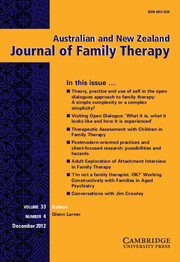No CrossRef data available.
Article contents
Family Therapy in France: An Australian Perspective
Published online by Cambridge University Press: 02 March 2012
Abstract
This article is an exploration of family therapy in France by an Australian social worker and family therapist. It also reports on the 2010 European Family Therapy Conference and includes an interview with Dr Mony Elkaïm that provides an overview of his work. All this is discussed in terms of its relevance for family therapists in Australia. It is followed by a brief response from Dr Elkaïm.
- Type
- Articles
- Information
- Australian and New Zealand Journal of Family Therapy , Volume 32 , Issue 4 , December 2011 , pp. 314 - 328
- Copyright
- Copyright © Cambridge University Press 2011
References
Bergo, B. (2008). Emmanuel Levinas. The Stanford encyclopedia of philosophy (Fall 2011 Ed.). Retrieved from http://plato.stanford.edu/archives/fall2011/entries/levinas/Google Scholar
Bonnet, J. (2009). Délinquance: Comment interpréter les chiffres? Sciences Humaines, Mensuel 208, 54–57.Google Scholar
Centre hospitalier de Saumur, Service de psychiatrie de l'enfant et de l'adolescents (2011). www.chsaumur.fr/chs2/s_centre_psy_1.htmGoogle Scholar
Deleuze, G., & Guattari, F. (1991). Qu'est-ce que la philosophie? France: Les Editions de Minuit.Google Scholar
Dosse, F. (2009). Deleuze: Une philosophie du mouvement. Sciences Humaines, Hors-série Spécial 9, 80–81.Google Scholar
EFTA (European Family Therapy Association). (2011a). Homepage. Retrieved from http://www.europeanfamilytherapy.eu/index.phpGoogle Scholar
EFTA (European Family Therapy Association) (2011b). Newsletter 9. Retrieved from http://www.europeanfamilytherapy.eu/content.php?idt=10&idnl=9Google Scholar
Ehrenberg, A. (1998). La fatigue d'être soi. Dépression et société. France: Odile Jacob.Google Scholar
Elkaïm, M. (1995a). Constructivisme, constructionnisme social et narrations: Aux limites de la systémique? In Elkaïm, M. (éd.), Panorama des thérapies familiales (pp. 505–532). Paris: Editions de Seuil.Google Scholar
Elkaïm, M. (1995b), Description d'une évolution. In Elkaïm, M. (éd.), Panorama des thérapies familiales (pp. 587–612). Paris: Editions de Seuil.Google Scholar
Elkaïm, M. (1995c). Les approches systémique, structurale et stratégique en thérapie familiale. In Elkaïm, M. (éd.), Panorama des thérapies familiales (pp. 159–172). Paris: Editions de Seuil.Google Scholar
Elkaïm, M. (2006). Quelques points à propos d'autoréférence et de thérapie familiale. In Elkaïm, M. (éd.), La thérapie familiale en changement. Paris: Les empêcheurs de penser en rond.Google Scholar
Flaskas, C. (2002). Family therapy beyond postmodernism: Practice challenges theory. UK: Brunner-Routledge.Google Scholar
Ginger, S. (2009). Statut et formation des psychothérapeutes. Sciences Humaines, Trimestriel 15, 16–18.Google Scholar
La FD CMPP (Federation des Centres Médico Psycho Pédagogiques). (2011). Retrieved from http://www.fdcmpp.fr/caracteristiques.html.Google Scholar
Le Goff, J. F. (1999). Family therapy in France: A brief overview. Contemporary Family Therapy, 21(1), 77–88.CrossRefGoogle Scholar
Marmion, J. F. (2009a). Enfance: Querelles autour de la violence. Sciences Humaines, Mensuel 208, 36–41.Google Scholar
Marmion, J. F. (2009b). ‘Guerre des psys’: à quand l'armistice? Sciences Humaines, Trimestriel 15, 14–15.Google Scholar
Meyer, C. (éd.) (2005). Le livre noire de la psychanalyse. Vivre, penser et aller vivre sans Freud. France: Les Arènes.Google Scholar
Pelissolo, A. (2009). Psychothérapie ou médicaments? Sciences Humaines, Trimestriel 15, 28–29.Google Scholar
REAAP (Réseau d'Ecoute, d'Appui et d'Accompagnement des Parents de la Manche). Retrieved from http://www.reseau-parental50.net/definitions/cmp.htmGoogle Scholar
Trappeniers, E. (éd.) (2004). Résonances, 9, 12–27. [Le lien homepage]. Retrieved from http://www.therapie-familiale.org/etude/try.htmlGoogle Scholar
Vaillé, H. (2005). Antidépresseurs: Un choix collectif? Sciences Humaines, Hors-série 50.Google Scholar


